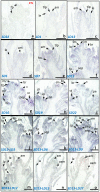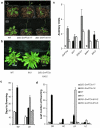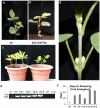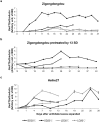GmFT2a, a soybean homolog of FLOWERING LOCUS T, is involved in flowering transition and maintenance
- PMID: 22195028
- PMCID: PMC3237611
- DOI: 10.1371/journal.pone.0029238
GmFT2a, a soybean homolog of FLOWERING LOCUS T, is involved in flowering transition and maintenance
Abstract
Background: Flowering reversion can be induced in soybean (Glycine max L. Merr.), a typical short-day (SD) dicot, by switching from SD to long-day (LD) photoperiods. This process may involve florigen, putatively encoded by FLOWERING LOCUS T (FT) in Arabidopsis thaliana. However, little is known about the potential function of soybean FT homologs in flowering reversion.
Methods: A photoperiod-responsive FT homologue GmFT (renamed as GmFT2a hereafter) was cloned from the photoperiod-sensitive cultivar Zigongdongdou. GmFT2a gene expression under different photoperiods was analyzed by real-time quantitative PCR. In situ hybridization showed direct evidence for its expression during flowering-related processes. GmFT2a was shown to promote flowering using transgenic studies in Arabidopsis and soybean. The effects of photoperiod and temperature on GmFT2a expression were also analyzed in two cultivars with different photoperiod-sensitivities.
Results: GmFT2a expression is regulated by photoperiod. Analyses of GmFT2a transcripts revealed a strong correlation between GmFT2a expression and flowering maintenance. GmFT2a transcripts were observed continuously within the vascular tissue up to the shoot apex during flowering. By contrast, transcripts decreased to undetectable levels during flowering reversion. In grafting experiments, the early-flowering, photoperiod-insensitive stock Heihe27 promotes the appearance of GmFT2a transcripts in the shoot apex of scion Zigongdongdou under noninductive LD conditions. The photothermal effects of GmFT2a expression diversity in cultivars with different photoperiod-sensitivities and a hypothesis is proposed.
Conclusion: GmFT2a expression is associated with flowering induction and maintenance. Therefore, GmFT2a is a potential target gene for soybean breeding, with the aim of increasing geographic adaptation of this crop.
Conflict of interest statement
Figures








Similar articles
-
Functional diversification of Flowering Locus T homologs in soybean: GmFT1a and GmFT2a/5a have opposite roles in controlling flowering and maturation.New Phytol. 2018 Feb;217(3):1335-1345. doi: 10.1111/nph.14884. Epub 2017 Nov 9. New Phytol. 2018. PMID: 29120038 Free PMC article.
-
Two coordinately regulated homologs of FLOWERING LOCUS T are involved in the control of photoperiodic flowering in soybean.Plant Physiol. 2010 Nov;154(3):1220-31. doi: 10.1104/pp.110.160796. Epub 2010 Sep 23. Plant Physiol. 2010. PMID: 20864544 Free PMC article.
-
A GmRAV ortholog is involved in photoperiod and sucrose control of flowering time in soybean.PLoS One. 2014 Feb 14;9(2):e89145. doi: 10.1371/journal.pone.0089145. eCollection 2014. PLoS One. 2014. PMID: 24551235 Free PMC article.
-
Molecular mechanisms for the photoperiodic regulation of flowering in soybean.J Integr Plant Biol. 2021 Jun;63(6):981-994. doi: 10.1111/jipb.13021. Epub 2021 Apr 26. J Integr Plant Biol. 2021. PMID: 33090664 Review.
-
Molecular Genetic Understanding of Photoperiodic Regulation of Flowering Time in Arabidopsis and Soybean.Int J Mol Sci. 2021 Dec 31;23(1):466. doi: 10.3390/ijms23010466. Int J Mol Sci. 2021. PMID: 35008892 Free PMC article. Review.
Cited by
-
The interplay of phloem-mobile signals in plant development and stress response.Biosci Rep. 2020 Oct 30;40(10):BSR20193329. doi: 10.1042/BSR20193329. Biosci Rep. 2020. PMID: 32955092 Free PMC article. Review.
-
Molecular breeding for improvement of photothermal adaptability in soybean.Mol Breed. 2023 Jul 24;43(8):60. doi: 10.1007/s11032-023-01406-z. eCollection 2023 Aug. Mol Breed. 2023. PMID: 37496825 Free PMC article.
-
Functional diversification of Flowering Locus T homologs in soybean: GmFT1a and GmFT2a/5a have opposite roles in controlling flowering and maturation.New Phytol. 2018 Feb;217(3):1335-1345. doi: 10.1111/nph.14884. Epub 2017 Nov 9. New Phytol. 2018. PMID: 29120038 Free PMC article.
-
Flowering process in soybean under water deficit conditions: A review on genetic aspects.Genet Mol Biol. 2021 Dec 13;45(1):e20210016. doi: 10.1590/1678-4685-GMB-2021-0016. eCollection 2021. Genet Mol Biol. 2021. PMID: 34919115 Free PMC article.
-
A Novel Sucrose-Regulatory MADS-Box Transcription Factor GmNMHC5 Promotes Root Development and Nodulation in Soybean (Glycine max [L.] Merr.).Int J Mol Sci. 2015 Aug 31;16(9):20657-73. doi: 10.3390/ijms160920657. Int J Mol Sci. 2015. PMID: 26404246 Free PMC article.
References
-
- Bäurle I, Dean C. The timing of developmental transitions in plants. Cell. 2006;125:655–664. - PubMed
-
- Bernier G, Périlleux C. A physiological overview of the genetics of flowering time control. Plant Biotechnol J. 2005;3:3–16. - PubMed
-
- Simpson GG, Dean C. Arabidopsis, the Rosetta stone of flowering time? Science. 2002;296:285–289. - PubMed
-
- Kobayashi Y, Weigel D. Move on up, it's time for change—mobile signals controlling photoperiod-dependent flowering. Genes Dev. 2007;21:2371–2384. - PubMed
Publication types
MeSH terms
Substances
Associated data
- Actions
LinkOut - more resources
Full Text Sources
Other Literature Sources
Molecular Biology Databases
Research Materials
Miscellaneous

